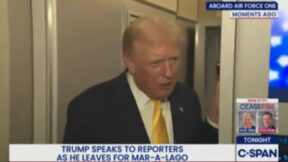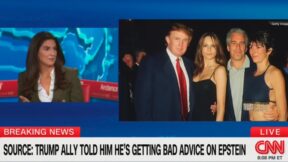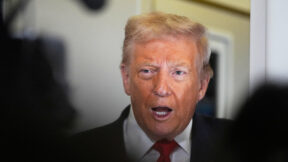CNBC Drops Brutal Breakdown on ‘Real Cost’ of Trump Tariffs
CNBC senior retail reporter Courtney Reagan dropped a brutal and exclusive breakdown on the “real cost” of President Donald Trump’s tariffs. Spoiler alert: it’s a lot.
To paraphrase an adage, if you don’t like the news about tariffs in the Trump era, just wait a few minutes. Trump’s habit of whiplashing between issuing massive tariff threats and backing off of them even spawned the derisive Wall Street acronym TACO — “Trump Always Chickens Out” — to describe a “TACO trade” strategy to outsmart Trump’s chaotic market-roiling tariff policies.
On Tuesday’s edition of CNBC’s Squawk Box, Reagan told co-host Becky Quick that a CNBC-exclusive model shows the “worst case scenario” of Trump’s policies:
BECKY QUICK: While tariff policy remains in flux, retailers have to decide what to do. Either mitigate the tariff cost, find a way to make up for it, or pass it along in prices.
Most large retailers are trying to work on mitigation strategies, although Walmart and Macy’s are among those that have said that even with mitigation, some prices will increase.
But what if the retailers didn’t mitigate it, or couldn’t, and stay in business? Here’s Courtney Reagan to explain it.
And, Court, I get the feeling that even those who aren’t talking about it as publicly are realizing they are gonna have to pass some cost on consumers in some areas.
COURTNEY REAGAN: Absolutely, and this is very nuanced. So we’re gonna try to simplify this as much as possible in sort of a worst case scenario. The true cost of tariffs is almost impossible to quantify.
But if a retailer didn’t or couldn’t absorb the cost and passed it all on, how much would prices increase? Well, Alex Partners built these example models exclusively for us to illustrate it.
So before the April 2nd tariffs, a cotton men’s sweater made in China cost $6.80 to produce.
Pre-liberation day, a 41.5% total tariff was already in place for that sweater shipped to the U.S. That equals $2.82. The cost of logistics and sourcing that adds another 95 cents.
So put together, the total cost of making that sweater is $10.57. At a typical initial markup rate to get to a 65% gross margin, the retail price before liberation day for that sweater would have been 30 bucks.
So here’s the same sweater at today’s tariff rates. The China manufacturing costs, logistics and sourcing costs, those are constant in this example.
But at the 41 and a half percent existing tariff for that sweater before April 2nd, and then the 10% universal rate, 20% fentanyl tariff, the current tariff rate is 71.5% of the manufacturing cost, or $4.86, making the new cost the retailer pays to make that sweater $12.61.
So holding that 65% markup to maintain that level of profitability and a new price the consumer would pay, $35.80. So that’s a price increase of more than 19%.
BECKY QUICK: That’s only if you pass the entire cost on.
COURTNEY REAGAN: If you pass the entire cost on, right now, at where we’re sitting today.
So let’s look what happens if the full tariffs announced April 2nd would be enforced. At that 41.5% pre-April 2nd existing tariff for that sweater, plus the additional 145%, the tariff rate is 186.5 percent for the sweater, or a tariff cost of $12.68, making the new cost the retailer pays to make this sweater. $20.43. So if you use that same 65% markup to maintain the level of profitability, the new price of consumer pays $57.97.
That is an increase of 92.3%, almost double the original retail price.
Watch above via CNBC’s Squawk Box.




